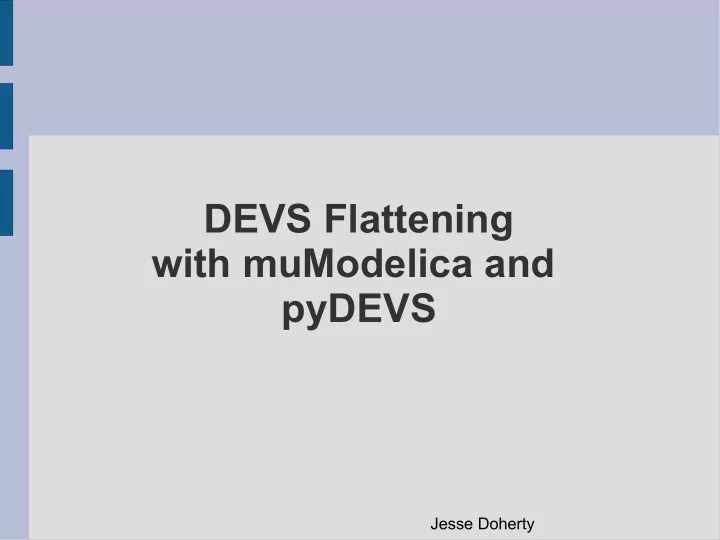

DEVS Flattening with muModelica and pyDEVS Jesse Doherty
Outline ● Introduction ● Motivations ● Tools ● Solution ● Conclusion
Introduction ● DEVS – Atomic 〈 S ,ta, int , X , ext ,Y , 〉 – Coupled 〈 X self ,Y self , D, { M i } , { I i } , { Z ij } ,select 〉
Introduction ● DEVS – Closed under coupling, through flattening – Closure Procedure 〈 X self ,Y self , D, { M i } , { I i } , { Z ij } ,select 〉 〈 S ,ta, int , X , ext ,Y , 〉
Motivation ● Why do we use a coupled DEVS solver?
Motivation ● Why do we use a coupled DEVS solver? – Solver can be parallelized – Solving the original system seems more satisfying – Solving through flattening still requires an atomic solver
Motivation ● Why would we want to flatten?
Motivation ● Why would we want to flatten? – Static analysis – Optimizations – Tools become less complex
How? ● Seems simple – take some cross products – find some minimums – keep track of some time – forward some transition functions
Problems ● Questions come up quickly – how do we specify DEVS – how do we represent them – how do we transform them – how do we solve them
Tools ● Modelica ● muModelica ● Devs in Modelica ● Python Devs
Modelica ● Object oriented model description language – not a programming language ● Highly structured ● Suitable for high-level model description
muModelica ● Modelica compiler originally intended to target octave code ● Written in python ● Extendable ● Provides an AST of input code
DEVS in Modelica ● Set of Modelica classes used to represent DEVS components – Events – State – Port – Atomic DEVS – Coupled DEVS ● More structured than pydevs representation
DEVS in Modelica ● Functionality added to muModelica to DEVS semantics and output pydevs code ● Some restrictions – submodels must be explicitly listed – atomic DEVS' states are expected to have a sequential state component (though not enforced)
PyDEVS ● All seen before
Ideal Solution ● For each coupled DEVS – produce a new atomic DEVS with ● state equivalent to a combination of all sub model states ● transition, output and ta functions are an inlining of component functions – discard original AST and produce AST for just the new atomic DEVS
Initial Solution ● Maintain original AST structure ● Create new flattened versions of coupled models ● State of these flattened versions would consist of a list of instances of component models, and an elapsed time for each ● For each function, perform appropriate logic and forward the function to the needed component models
Current Solution ● While producing python code for modelica models, also produce python code for flattened DEVS models ● Benefits: – Simpler to implement, direct access to python language ● Drawbacks: – loose access to structure of flattened model
Encountered Problems ● muModelica AST can be clumsy when dealing with DEVS structure ● Need a useful way of representing combined states, for use in analysis
Conclusion ● Flattening might be useful ● More specialized tools for dealing with DEVS structure would be needed produce useful analysis
Recommend
More recommend